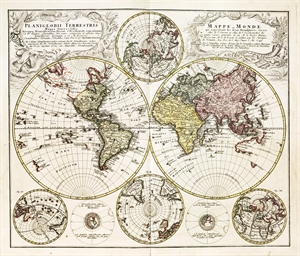[Composite Atlas.] [Nuremberg: Homann Heirs, c.1750]. 2 volumes. Folio (530 x 320 mm). Double-page table, 200 hand-colored maps and city plans (199 double-page, one folding). Bound in half 18th-century Russia over contemporary marbled boards, spine in six compartments, gilt double fillets and lettered in gilt. Chipping to boards, slight wear. Homann composite atlas including a double-hemispheric celestial map, continental maps of Europe, Africa and Asia, a map of the Holy Land, general and region specific maps of most European countries, as well as numerous city plans (including Paris, Madrid, Florence, Rome, Venice, Vienna, Berlin, Stockholm, Copenhagen, St. Petersburg and Constantinople, among others). It is unusual to find such atlases with full period hand-coloring throughout and with such a large number of city plans, city views, and maps (by comparison the largest such Homann composite atlas in the British Library contains 175 maps). Including maps dated as early as 1732, the present composite atlas was likely assembled circa 1750. Founded in Nuremberg by Johann Baptist Homann in 1702, the Homann family became one of the most important map publishing houses in Germany and their empire dominated Germany's map market for over a century. Homann published his first major atlas in 1707 and was soon after appointed Geographer to the Emperor. After Homann's death in 1724, the firm was continued by his son, and eventually bequeathed to his heirs with the stipulation that it conducted business under the name of Homann Heirs. The Homann family continued to produce maps until the beginning of the nineteenth century, and remained one of the most important German publishers on the Continent. Heinz, M. "A Programme for Map Publishing: The Homann Firm in the Eighteenth Century" in Imago Mundi Vol. 49, 1997, pp 104-115; Phillips 586; Shirley, Atlases, T.HOM-1a-11a.
[Composite Atlas.] [Nuremberg: Homann Heirs, c.1750]. 2 volumes. Folio (530 x 320 mm). Double-page table, 200 hand-colored maps and city plans (199 double-page, one folding). Bound in half 18th-century Russia over contemporary marbled boards, spine in six compartments, gilt double fillets and lettered in gilt. Chipping to boards, slight wear. Homann composite atlas including a double-hemispheric celestial map, continental maps of Europe, Africa and Asia, a map of the Holy Land, general and region specific maps of most European countries, as well as numerous city plans (including Paris, Madrid, Florence, Rome, Venice, Vienna, Berlin, Stockholm, Copenhagen, St. Petersburg and Constantinople, among others). It is unusual to find such atlases with full period hand-coloring throughout and with such a large number of city plans, city views, and maps (by comparison the largest such Homann composite atlas in the British Library contains 175 maps). Including maps dated as early as 1732, the present composite atlas was likely assembled circa 1750. Founded in Nuremberg by Johann Baptist Homann in 1702, the Homann family became one of the most important map publishing houses in Germany and their empire dominated Germany's map market for over a century. Homann published his first major atlas in 1707 and was soon after appointed Geographer to the Emperor. After Homann's death in 1724, the firm was continued by his son, and eventually bequeathed to his heirs with the stipulation that it conducted business under the name of Homann Heirs. The Homann family continued to produce maps until the beginning of the nineteenth century, and remained one of the most important German publishers on the Continent. Heinz, M. "A Programme for Map Publishing: The Homann Firm in the Eighteenth Century" in Imago Mundi Vol. 49, 1997, pp 104-115; Phillips 586; Shirley, Atlases, T.HOM-1a-11a.

.jpg)













Testen Sie LotSearch und seine Premium-Features 7 Tage - ohne Kosten!
Lassen Sie sich automatisch über neue Objekte in kommenden Auktionen benachrichtigen.
Suchauftrag anlegen